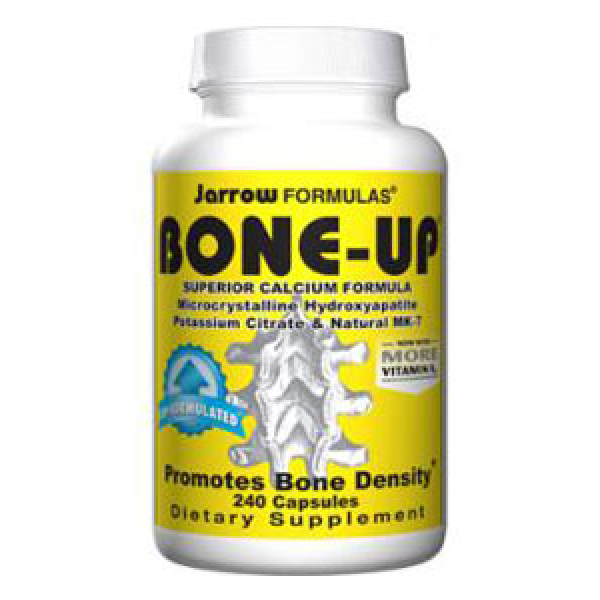Throughout life, cells known as osteoblasts construct bone matrix and fill it with calcium. At the same time, osteoclasts work just as busily to tear down and resorb bone. This fine balance is regulated by many factors, including systemic hormones and cytokines. Bone mass reaches its peak by the middle of the third decade of life and plateaus for about ten years, during which time bone turnover is constant, with bone formation approximately equaling bone resorption.1,2 As our bodies age, this fine balance is lost. As the relative hormone levels shift in midlife — more drastically in women than in men — the osteoclasts gain the upper hand and bone mass begins to dwindle. Some bone is already being lost by the time women reach menopause, but the rate of loss can increase up to tenfold during the first five years after menopause.2-4 From midlife on, bone health is threatened by an increasing imbalance between osteoblast and osteoclast coupling function.5 Additionally, osteoblasts may become less active from age 60 on. Whereas trabecular (spongy-looking) bone in the vertebrae and elsewhere was formerly at risk from excess osteoclast activity, now the cortical (dense) bone of the hip, shin, pelvis, and other sites becomes more prone to damage because osteoblasts don’t make enough of it.6,7 Weight-bearing exercise, eating a variety of healthy foods and avoiding tobacco and alcohol can help maintain healthy bones. Foods that promote bone health include mineral and vitamin sources — dark green leafy vegetables, broccoli, legumes, canned salmon, sardines — and dairy products like milk and cheese.8-15 Scientific literature documents the need for a wide range of minerals and vitamins vital to maintaining strong, healthy bones ... including magnesium, calcium, and vitamin D. Magnesium is one of the body’s most important minerals. In bone mineral health, magnesium (or lack of it) influences the bone mineral matrix and its ability to metabolize needed minerals for repair and rebuilding.16 Calcium is the most abundant mineral in the body, primarily found in bones and teeth. In bone formation, together with vitamin D, calcium forms crystals that provide strength to maturing bone. Calcium and vitamin D are also needed to maintain healthy cartilage.17-19 Calcium is needed for more than just healthy bones. It is also important for muscle contraction, blood vessel contraction and expansion, the secretion of hormones and enzymes, and sending messages through the nervous system. A meta-analysis of 56 clinical trials demonstrated a significant impact on heart health as a result of increased calcium intake by 1,000 to 2,000 mg/day.23 In addition, scientific evidence suggests that increased intake of calcium may help to maintain optimal weight as well.24-27 Magnesium is one of the body’s most important minerals. It is required as a cofactor in hundreds of enzymatic processes within cells.28 It helps maintain normal muscle and nerve function, keeps heart rhythm steady, promotes healthy cardiovascular function, supports a healthy immune system, and keeps bones strong. Magnesium also helps maintain blood sugar and blood pressure levels already within normal range, and it is known to be involved in energy metabolism and protein synthesis.29,30 Magnesium is a major factor in relaxing the smooth muscles within the blood vessels, thereby reducing peripheral vascular resistance and promoting a healthy cardiovascular system.31-33 Magnesium also affects circulating levels of norepinephrine and the synthesis of serotonin and nitric oxide.34-36 Magnesium positively influences the bone mineral matrix and its ability to metabolize minerals needed for repair and rebuilding.37,38 Scientific literature documents the need for a wide range of minerals, including calcium and magnesium, that are vital to maintaining strong, healthy bones. Calcium and other minerals are best not taken with fiber, because fiber can interfere with their absorption.32-34 There is evidence that calcium from supplements and dairy foods may inhibit iron absorption, although it has been very difficult to distinguish between the effects of calcium on iron absorption versus other inhibitory factors, such as phytate.39-41 Although current understanding of this suggests that the inhibition of calcium on absorption of iron is of short duration and the body has adaptive mechanisms.42 Calcium supplements are best taken with meals. They should always be taken with a full glass of water, juice, or other liquid to enhance solubility.43 If calcium-containing formulas are taken only once daily, they may be best taken in the evening.44
| Serving Size 6 capsules |
| Servings Per Container 40 |
| Amount Per Serving |
| Vitamin C (as calcium ascorbate) |
200 mg |
| Vitamin D3 (cholecalciferol) |
1000 IU |
| Natural MK-7 (vitamin K2 as menaquinone-7) |
45 mcg |
| Calcium (elemental) (from microcrystalline hydroxyapatite) |
1000 mg |
| Magnesium (as magnesium oxide) |
500 mg |
| Zinc (L-OptiZinc) (as zinc monomethionate) |
10 mg |
| Copper (as copper gluconate) |
1 mg |
| Manganese (as manganese citrate) |
1 mg |
| Potassium (as potassium citrate) |
99 mg |
| Boron (as boron citrate) |
3 mg |
| Other ingredients: maltodextrin, magnesium stearate (vegetable source) and silicon dioxide. Capsule consists of gelatin Mineral amounts are elemental.. |
| Contains soy (in trace amounts).
No wheat, no gluten, no dairy, no egg, no fish/shellfish, no peanuts/tree nuts. | |
| Dosage and Use |
- Take three capsules twice per day with meals, preferably dividing the number of capsules equally with each meal (for a total of six) to facilitate maximum absorption or as directed by your qualified health care consultant.
|
| Warnings |
If you have a medical condition, are pregnant, lactating, trying to conceive, or taking medications (especially warfarin/Coumadin), consult your health care practitioner before this this product. |


